Zoos | Marine Parks | Racing | Circuses | Horse-Drawn Carriages | Rodeos | Pig Wrestling
When we use our fellow animals for entertainment, such as in the case of rodeos, races, and circuses, innocent victims are forced to “perform” to their owners’ standards, often with beatings, intimidation, and torture, and always under the threat of death for poor performance. Every aspect of their lives, from “training” to transportation, is controlled to maximize the benefits and minimize the costs to their owners, so that their interests are ignored, except for the minimum necessary to keep them alive and performing. The result is a short life of stress, hunger, extreme boredom from long periods of confinement, and physical distress from extreme heat or cold. When their ability to perform begins to wane, they are usually “thanked” with a death sentence at a young age. This is what it means to be owned and unprotected by legal rights in a speciesist world.
Zoos
Zoos purport to be benefactors to the animals in their control and bastions of conservation to the many species of animals humans have endangered. This gloss is a misleading distortion at best. Some zoos may cite their breeding programs in order to bolster the credibility of their claims of conservation and animal stewardship. However, these breeding programs are unable to provide the genetic diversity that would preserve a species in any meaningful way. And very few of these animals will ever be released back into their natural habitats, remaining entrenched in a system that views animals as objects of entertainment.
We must also consider that the conservation argument, specious as it proves to be, does not grant individual animals rights to autonomy and lives outside of human control.
The story of Ned the elephant demonstrates both the ineffectiveness of the United States’ weak-hearted animal protection laws and the total subjugation of individuals to the self-perpetuating system of animal use and objectification. Ned was born in 1987 to elephants captured in Southeast Asia and legal property of Roman Schmitt, an elephant trainer and manager of the Busch Gardens elephant breeding program. When he was two, Ned was sold into a circus and sold again to another circus ten years later. It was at this point his deteriorating condition and emaciated frame became so evident, he was confiscated by the USDA in 2008 and placed in a sanctuary. Despite the best efforts to revive him, Ned died after only six months.
 Photo: Jo-Anne McArthur/We Animals Media
Photo: Jo-Anne McArthur/We Animals Media
Even in the most well-funded zoos, animals who require wild and expansive habitats are excessively confined. But the most egregious of these is the bafflingly legal existence of roadside attractions and small, unaccredited zoos. Chain link fence enclosures, cement floors, social isolation, and grossly inadequate medical care are banal marks of these lingering grotesqueries of Americana. The sole purpose of these ‘attractions’ is to bring in paying customers to gawk at animals who clearly do not belong in these regions or habitats. The animals’ well-being is a consideration only inasmuch as the barest life is necessary to sustain the enterprise. Roadside zoos draw back the veil on what zoos and other institutions are genuinely about: profit-generating equations in which animals can only have the value we attribute to objects, completely stripped of the moral value of thinking, feeling beings.
Zoos are prisons for innocents who have done nothing to deserve the life sentence behind bars or in small enclosures, far in nature and distance from their natural habitat. Extreme boredom and the lack of a natural, social environment among their own species generally results in severe psychological pain and insanity over many years. For public relations purposes, zoos often claim they are educational centers, but watching other species in small enclosures is only a poor “education” in a spectacle of cruelty, even if children don’t realize the agony and unnatural conditions in which these innocent beings live. We can educate about other species and their natural environments in far more effective ways, and without unnecessarily harming other animals, by abolishing zoos and using videography and documentaries showing other species free in their natural environments.
Marine Mammal Theme Parks & Public Aquariums
A public aquarium or oceanarium is the equivalent of a zoo for sea animals. These facilities mostly consist of large water tanks in which kidnapped or captive-bred marine animals are imprisoned, and in some cases forced to learn tricks and participate in performances for the entertainment of the paying public.
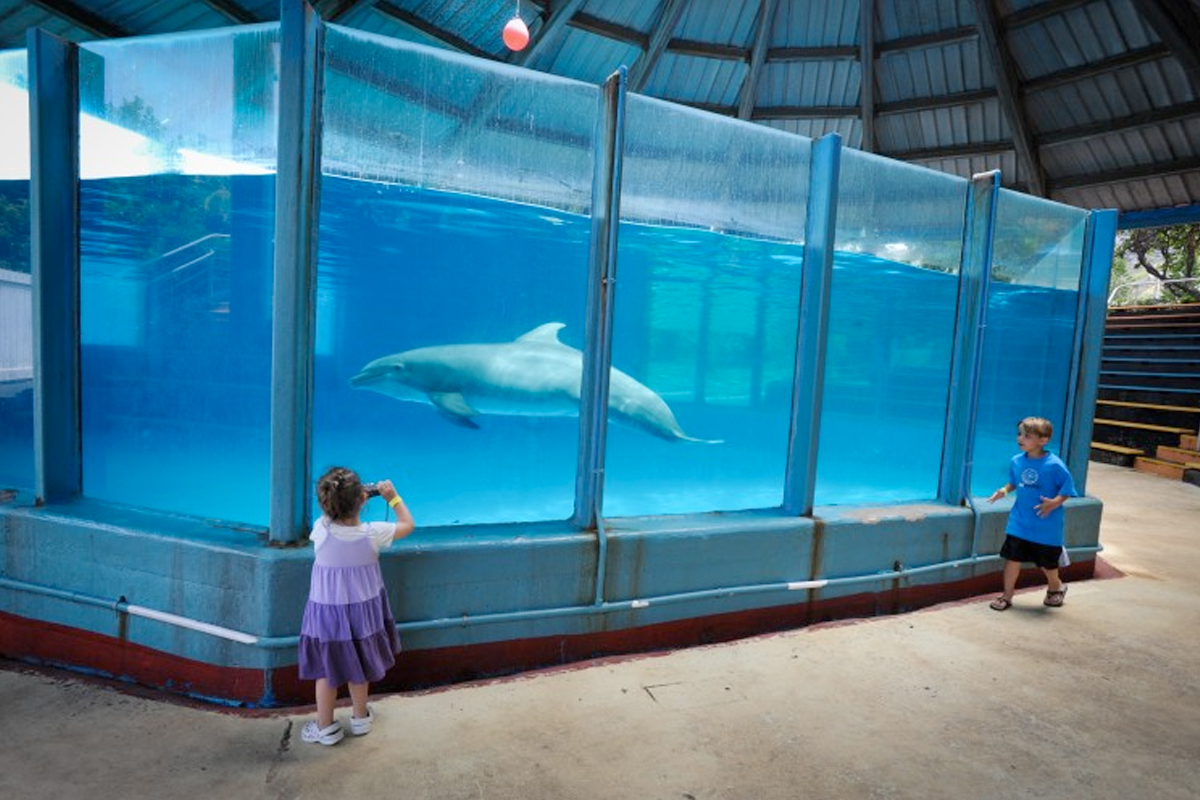
Photo: Jo-Anne McArthur/We Animals Media
Because we are starting to wake up to the problematic nature of seeking entertainment through someone else’s captivity, many of these businesses promote their purported “education” or “conservation” goals, suggesting that aquariums somehow help and protect their captives by engaging in conservation projects and educational efforts. The fact is, however, that no matter what other activities they engage in, aquariums require abduction, confinement, and deprivation of everything an individual values in life, and this debasement is viewed as amusement while being sold as having educational and scientific value. Marine animals held in captivity live in what can only be reasonably described as an aqua-prison, and this hugely profitable business of exploitation adds up to a multimillion dollar industry.
Some aquariums even sell sea animals to the public (including arthropoda, starfishes, molluscs, or marine fishes). Some include the marine equivalent of a petting zoo, encouraging visitors to touch and handle rays, starfish, whelks, and clams, or to swim with dolphins, combining the torment of confinement with the further degradation and terror of being touched incessantly by strangers, with or without innocent intent. Other aquariums offer “birthday party experiences for children,” and some “mobile aquariums” are brought to schools, festivals, or parties.
The individuals in captivity can belong to any sea or semi-aquatic animal species, with the most common being rays, dolphins, sharks, seahorses, octopuses, whales, seals, sea lions, turtles, crocodiles, iguanas, otters, and penguins.
Unless born into the confusion and demoralization of captivity, these individuals are first torn apart from their families at sea as well as their natural home of the sea itself. Many die while in transit, due to the extreme stress they experience. While in captivity, their lives are short as they are prone to psychological as well as physical afflictions as the result of the completely unnatural (and often unsanitary) environment and conditions they are forced to endure.
Just as we see in land animals held in captivity in zoos, captive marine individuals exhibit stereotypically disturbed behaviors, i.e. repetitive motor behaviors like swimming in circles or self-injury. Sometimes they behave most unlike they would in their natural environment, such as by harming or killing someone (human or otherwise) when such an act would be unheard of from a free-living individual of their species.
When at sea, these species form social groups of complex structure and varied relationships, and swim enormous distances daily. In the ocean, many spend most of their days in quiet shelter hiding from predators, and living side by side with their families for years. Orcas, for example, live by the sides of their mothers all their lives. They travel in groups, experience the security and stimulation of social networks, develop strong bonds with family and friends, and enjoy lives in which loud human voices, artificial lights, and crowds of people are absent and are, subsequently, a trigger for fear, severe stress, and (over time) depression. Dolphins navigate via echolocation, but this very ability causes them severe psychiatric as well as physical illnesses when confined in the limited structures of pools or tanks.
When exploited by us, these individuals commonly die young from depression, chronic stress, exhaustion, neglect, captivity related illnesses, or internal injuries due to the unnatural movements they are forced to make. We should not be surprised to learn that some of these dignified but humiliated captives end up committing suicide, by hitting their heads against the pool’s sides or by not resurfacing for air so they can die by asphyxiation.
Nevertheless, these prisons are often promoted and celebrated as state-of-the-art educational facilities, while the thousands of captive individuals known as “exhibits” or “collections” are alternately described as either “awe-inspiring curious creatures” to admire and even fear, or “spooky or creepy beasts” to look down upon or to be disgusted by. Visits to these places are often promoted as “an adventure” and are sometimes combined with playgrounds, “aquatic circus exhibits,” and even “sleepover sessions” for human children, taught to “love” nonhuman animals’ tragedy while watching the captives swimming beneath or above them, not necessarily realizing that they do so because they have no other choice.
In addition to large-scale facilities built as commercial ventures, this same disregard for the interests of nonhuman animals can be seen at a smaller scale, where aquariums are used for the amusement of humans who happen to find themselves in spaces such as shopping centers, offices, waiting areas (including veterinary clinics), shops or businesses. We even lock baby turtles or small fishes in transparent plastic bags just barely bigger than their bodies in order to use them as keyrings.
Genuine marine parks are areas of ocean that are protected from human activities, with the intention of allowing ocean wildlife to recover from “overexploitation.” Unfortunately, however, even in these cases, many of the zones categorized as parks are still used for activities such as boating, snorkelling, scuba diving, “sport” fishing, and even commercial fishing, with marine parks divided into zones which allow different human activities.
There are a number of scientists who strongly disagree with the way these nature-based marine parks function, claiming that they don’t balance business and profit with “conservation management.” But even “conservation” projects carried out with the intention of “protecting” particular species can be devastating to the individuals we are supposed to protect, since they often involve relocating some species, exterminating others, destroying family units, or setting boundaries to their lives that might have other consequences for them that we simply can’t foresee.
Nonhuman animals are not exhibits for our amusement, “playthings” for our entertainment, or our resources to use, any more than humans are, even “in moderation.” They are persons who value their lives, as well as life itself, and know for themselves what they want, where they want to be, and with whom they want to be. They most certainly don’t want to be deprived of their world, their home, their relationships with others and their environment, their dreams, their purpose, their freedom, or their lives.
Racing
The racing industry hijacks the bodies of horses and dogs, reducing suffering and death to mere financial considerations, and pushing these animals to physical extremes even as they endure neglect, abuse, and excessive confinement.
Horses used for racing are often overmedicated, masking and then compounding the pain of their injuries as they continue to run. The amount of drugs horses are forced to ingest may also contribute to significantly higher death rates at American tracks, where drug use is a much more entrenched practice. If an injury impedes performance, horses may be “euthanized” or sold to slaughterhouses where they will be killed for meat. In 2006, well-regarded trainer Steve Asmussen was suspended after one of the horses under his care was found to have 750 times the legal limit of anesthetic in her system. Asmussen, who has won over $214 million in purses, was also the subject of a 2014 undercover investigation. In the resulting video, he is seen discussing the severe pain of the animals in his care, referencing the use of electric shock, or “buzzing,” in training, and overseeing the overmedication of injured horses.
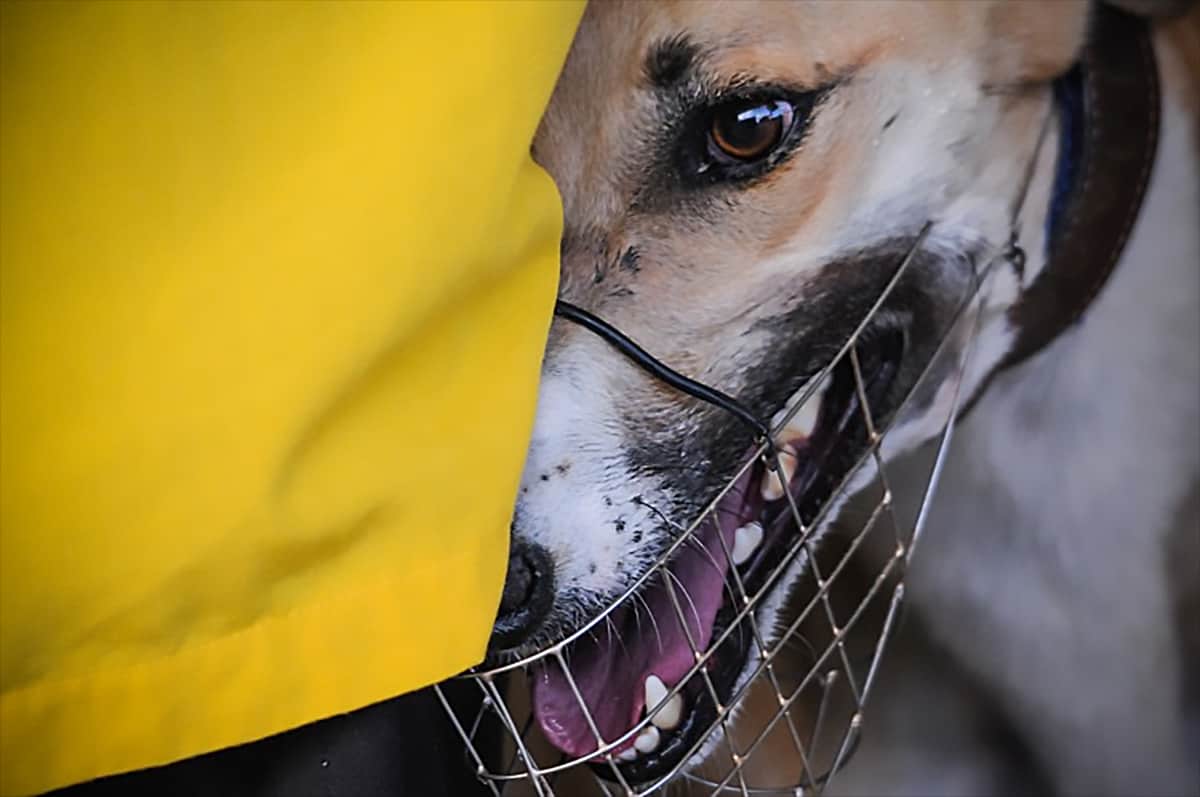 Photo: Jo-Anne McArthur/We Animals Media
Photo: Jo-Anne McArthur/We Animals Media
Greyhounds face many of the same abuses. In Florida, state records indicate that 483 greyhounds have died on the track or in kennels since 2013, following broken necks, heart attacks or electrocution from the high-voltage lures used to bait the dogs. Greyhounds may be confined for up to 20 hours a day then forced to run in excessive heat. Retired animals may find themselves sold to breeding facilities where their bodies continue to be instrumentalized, perpetuating this system of abuse. Not all those born in breeding facilities will go on to race. After reviewing data kept by the National Greyhound Association, the advocacy organization GREY2K found that over 8,000 puppies went unaccounted for between 2012 and 2014.
Circuses
Circuses subject wild animals to confinement, violent training practices, stress and anguish for the petty amusement of a human audience. Many of the animals forced into crates and cages require open spaces to exercise their natural behaviors. Social animals, like elephants, require the interaction, stimulation and support of their communities and are diminished by social isolation. Exacerbating these circumstances, circuses travel constantly, as much as eleven months out of the year. The stress and discomfort of these conditions take an enormous toll on wild animals who are meant to have access to dynamic spaces in their natural habitats. The psychological anguish this causes is painfully evident when lions and tigers are seen obsessively pacing in their enclosures, an image that will be familiar to many. This trauma is experienced viscerally as well. Capture myopathy is a disease associated with the capture and containment of wild animals that causes muscle damage, cardiac stress and, in some cases, sudden death.
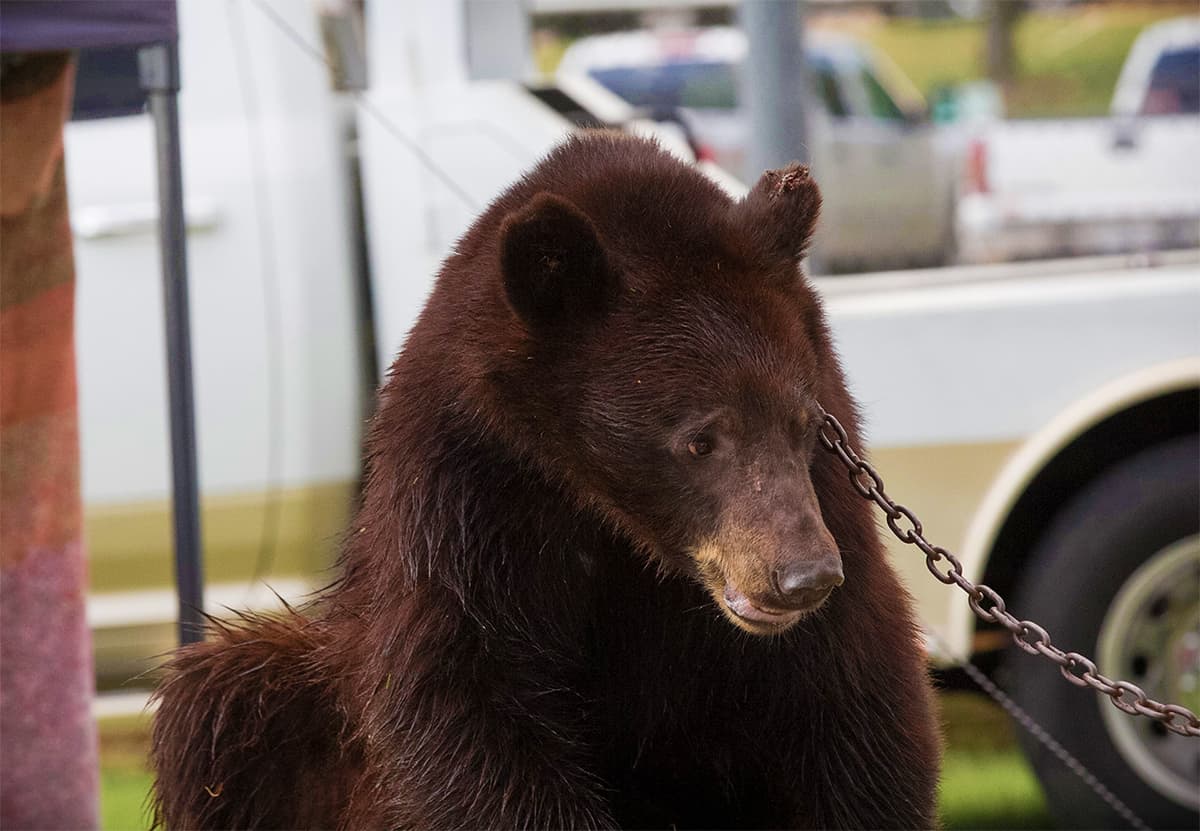 Photo: Unparalleled Suffering
Photo: Unparalleled Suffering
The excessive restrictions to free movement and bodily autonomy extend to forcing these animals to perform unnatural behaviors day after day. As these behaviors do not come easily, the training process may become violent and abusive. The use of bullhooks is a common component of training elephants. The sharp instruments jab, prod, and coerce the animals to perform out of fear and pain.
Given these conditions, it is not surprising that many animals have attacked their trainers or sought to escape their captivity, only to be met with further violence or recapture. The escape of Tyke the elephant may be one of the most iconic and tragic of these instances. In 1994, the twenty year old elephant escaped during a show in Honolulu, killing her trainer and severely injuring a groomer. Police chased her through the city until she finally succumbed to her injuries. She had been shot 87 times.
Horse-Drawn Carriages
In addition to the extreme anxiety caused to horses as a result of the over-stimulation from city sights, sounds and smells, there are many issues with horse-drawn carriages that may not be so readily apparent, but which add up to a living nightmare for the animals involved.
Horses are "flight" animals by nature, meaning they are easily startled, and instinctively flee from a perceived threat, rather than stand and fight it. In crowded and noisy city streets, this can easily lead to incidents of frightened horses running uncontrollably, sometimes with passengers in the carriage, putting both horse and human lives at risk.
If a horse is ultimately hit by a car, it is just as serious as it would be for a pedestrian, as a horse does not have any protection from an oncoming vehicle. Human bystanders, and the passengers of both cars and carriages alike, can also suffer grave bodily harm, or worse.
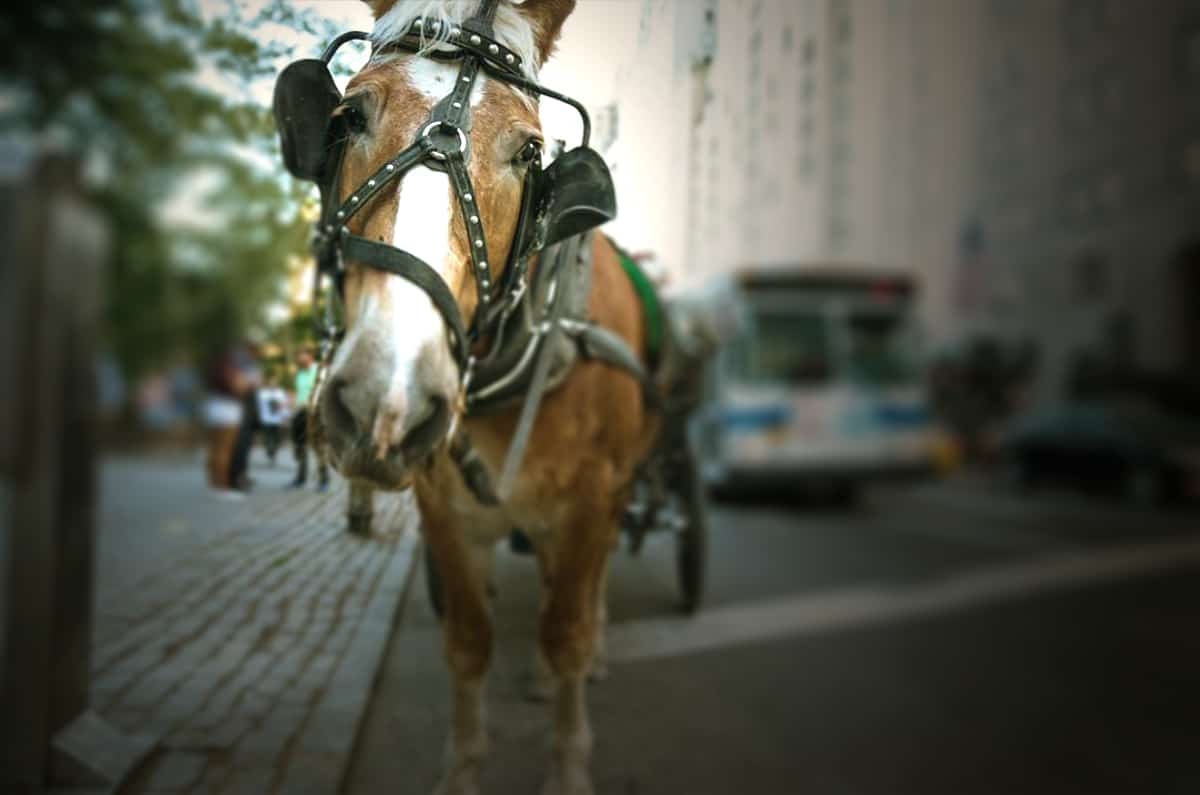 Photo: Unparalleled Suffering
Photo: Unparalleled Suffering
While stuck in heavy traffic, and forced to walk or stand behind running vehicles, horses breathe exhaust and other toxic fumes day in and day out, which can eventually cause serious and potentially fatal respiratory issues down the line.
Constantly walking on hard pavement (as opposed to grasslands, dirt, and other natural surfaces) puts major stress on the bones, muscles, joints, and hooves of the horses, and frequently leads to injuries or lameness.
Many carriage drivers also exacerbate an already bad situation by treating their horses like machines; forcing them to work in all weather/temperature extremes, and even denying them water so that they will not have to urinate. Combining hot weather with fluid restriction can lead to severe dehydration and heat exhaustion.
Just as in the racing industry, a horse who can't work or perform is seen as a financial burden. Since a horse who isn't earning money isn’t worth keeping, those who are slowing, aging or injured will either be “euthanized” or sent to the slaughterhouse to be sold as meat for human consumption.
Many cities, such as New York, have attempted to ban or impose limits on this outdated practice, but that has not come without pushback from carriage drivers and special interests with a financial stake in horse-drawn carriages. Even some celebrities have spoken out in favor of keeping them. Some drivers argue that their industry represents a living connection with the past, and needs to be protected as a means of historical preservation. However, that same flawed logic could be used to justify maintaining any wrongdoing of our past, whether it be killing whales for their oil or keeping other human beings as slaves.
Rodeos
Rodeo events consist of various different ‘sports’ that center around frightening, tormenting and abusing cows, horses and other farmed animals in the name of entertainment and competition.
In addition to the psychological and emotional distress, the animals used in these cruel forms of entertainment also frequently suffer from physical injury and even early death due to the inherently violent nature of rodeo contests.
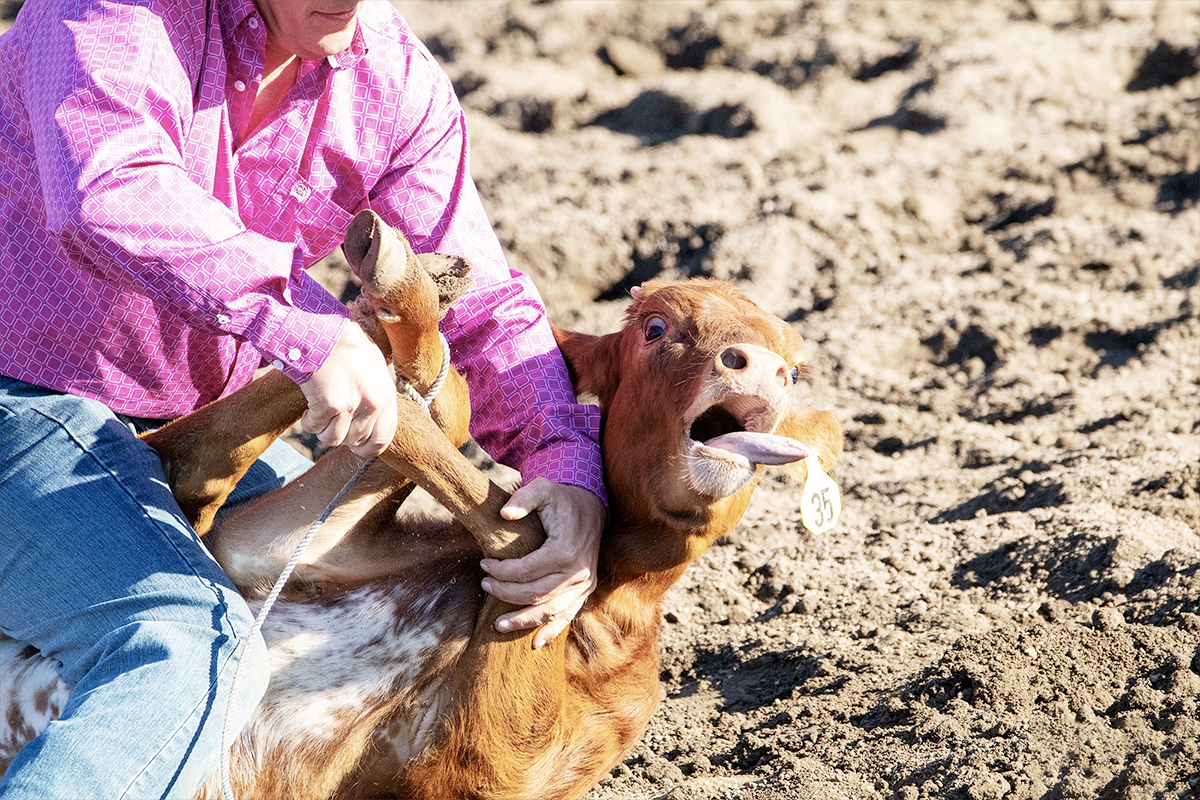
Photo: Unparalleled Suffering
Some of the most well-known activities in these contests are bull and bronc riding, where animals are purposefully agitated and provoked into aggressive behaviour through the use of ‘hot shots’ (cattle prods) and spurs to induce bucking. The infamous symbol of the bucking bull or bronco is not an innocent one, but is achieved by inflicting severe pain, and inducing a state of extreme distress. Bucking straps or flank straps are used to force the terrified animal to buck more frantically, causing the risk of back and leg strains and injuries.
Roping events make up the majority of rodeo activities, and are considered some of the most dangerous for the animals involved. Calves, usually around one year old, are first held in a confined space (chute) where their tails are twisted and they are subjected to shocks by cattle prod in order to make them run immediately after release. When released, they are quickly roped around the neck while running, and are then pushed to the ground and tied up by the rodeo contestant. Not only do these calves suffer psychologically and emotionally, they also risk significant physical injury and stress.
Steer wrestling—another common rodeo activity—involves physically restraining neutered male calves by the horns and forcing them to the ground. After being tormented in the chute, the steers are made to run as fast as they can while a person chases them on horseback. Once off the horse, the contestant will hold the steer’s horns and twist his head violently to push him to the floor.
Many more animals are also required for rodeo competitors to practice. Calves are frequently replaced in practice pens and are roped consecutively until they are no longer deemed useful and are killed.
The horrendous torment is not limited to the animals’ time within the rodeo. Animals are transported between rodeos over long distances in overcrowded trucks that quickly reach dangerous levels of heat, meaning that rodeo victims have little time to recover from injuries, as travel exacerbates their conditions and makes chances for future injury much more likely.
Pig Wrestling
At state fairs, county fairs and agricultural shows across the United States, pig wrestling events are promoted as a form of lighthearted entertainment. Conveniently left out of the marketing and advertising material, however, is the distress and pain inflicted on the young pigs forced to take part.
Agricultural shows and fairs are common destinations for family days out, and pig wrestling events often have ‘child-friendly’ pens with much smaller and younger pigs. It is a disturbing fact that children and young adults are encouraged to participate in these acts of unprovoked aggression against the vulnerable.
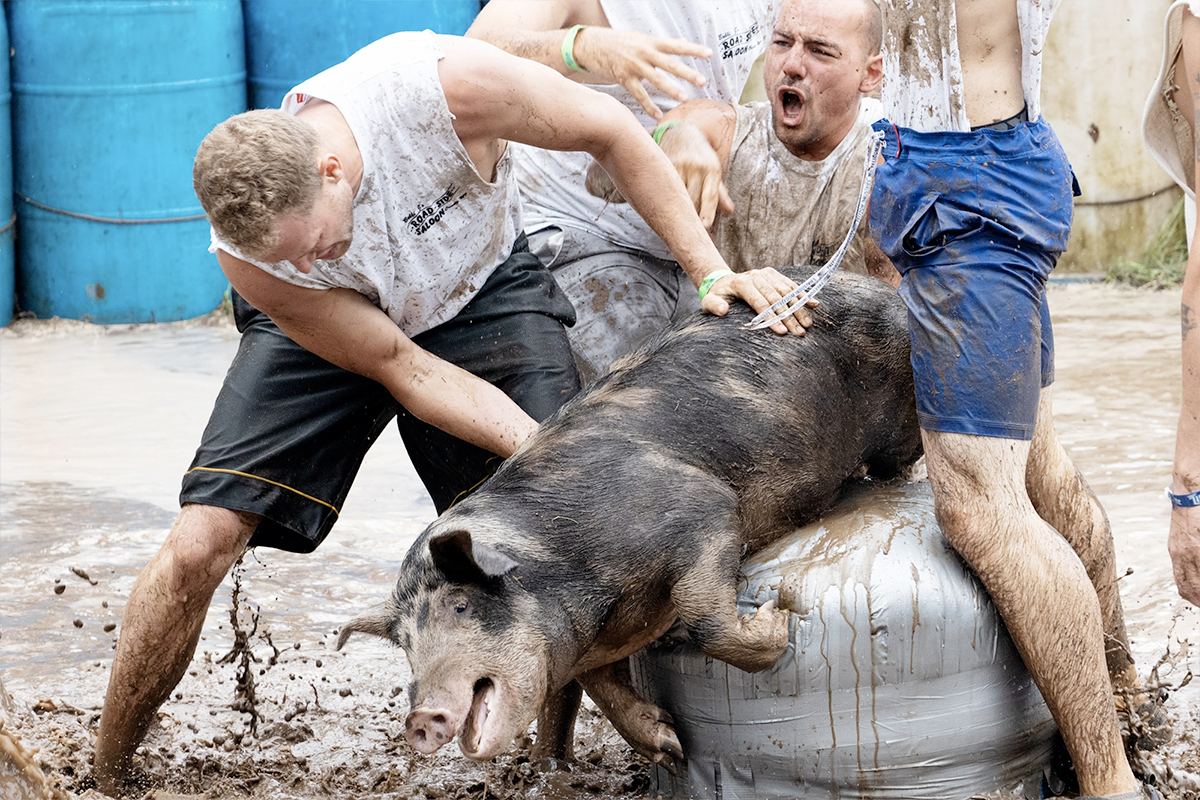
Photo: Unparalleled Suffering
Pig wrestling involves a group of people chasing a pig inside small, mud-filled pens in an attempt to force them to enter a barrel. The ultimate goal for pig wrestlers is to have the shortest time in the competition, so, adding to the insult of forcing pigs to do what they clearly don’t want to do, there is the very real injury they suffer because there’s no effort or incentive being made to ensure any sort of safety for the pig being chased. Pigs will fall, flail and struggle as they are grabbed, grappled and pulled by human hands. Due to the muddy ground, pigs struggle to move around freely, risking injury from losing their footing as well as from being wrestled by humans.
In order to induce the pig or piglet into a frantic state for chasing, the pigs are held within holding pens until they are eventually released into the mud ring. After spending hours within enclosed and confined spaces, the pigs generally leave their pens in a frantic stupor. Confusion is the intent here, as pigs are kept in dark conditions before being quickly rushed outside into bright sunlight, where they are immediately met by confrontational and aggressive humans.
Pigs are naturally very gentle, but most learn quickly to become fearful of human interaction. Those in charge of pig wrestling events understand that they require frightened pigs; without fear, the pigs would not make such frenzied attempts to avoid humans.
The distress imposed upon the pigs in these activities is not a matter of opinion, and we can very easily observe the results of the emotional harm being inflicted. Pigs let out high pitched squeals as they are chased, and race frantically around the mud pen in their desperation to avoid their pursuers.
Often times, once the pigs have been used for a wrestling event, they are hauled back onto transport trucks and are sent off to slaughter. There is no ‘reward’ for pigs who ‘perform’ better than others. All pigs used for pig wrestling will eventually be killed for consumption.